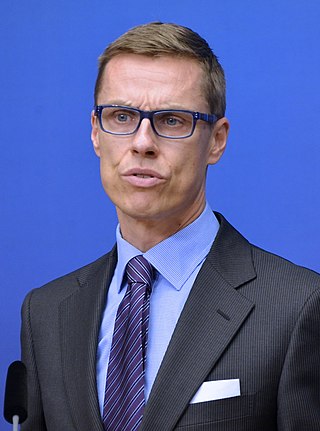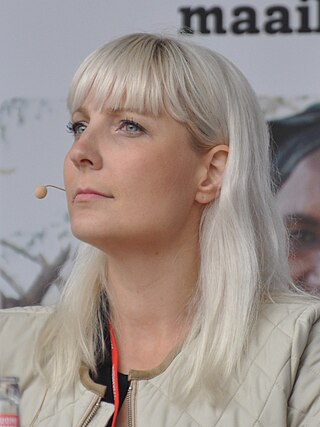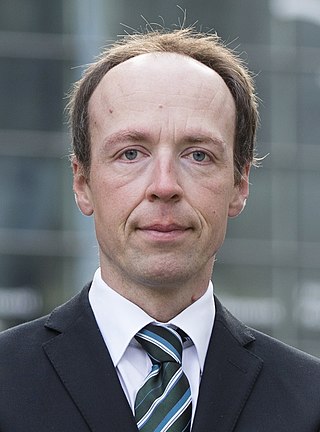Related Research Articles

The Finns Party, formerly known as the True Finns, is a right-wing populist political party in Finland. It was founded in 1995 following the dissolution of the Finnish Rural Party.

Timo Juhani Soini is a Finnish politician who is the co-founder and former leader of the Finns Party. He served as Deputy Prime Minister of Finland from 2015 to 2017 and Minister of Foreign Affairs from 2015 to 2019.
Northern Savonia was an electoral district represented in the Finnish Eduskunta (parliament). Since 2013 it has been part of the Savo-Karelia electoral district. It covered the administrative region of Northern Savonia, with a population of about 251,000. Northern Savonia currently elects ten members of the Eduskunta.

Parliamentary elections were held in Finland on 18 March 2007. Early voting was possible from the 7–13 March. The 200 members of the Eduskunta were elected from 15 constituencies.

Jutta Pauliina Urpilainen is a Finnish politician. She was the first female chair of the Social Democratic Party of Finland, which she led from 2008 to 2014. She was the Minister of Finance as well as the Deputy Prime Minister of Finland from 2011 to 2014. Since 1 December 2019, she is the European Commissioner for International Partnerships in the European Commission led by Ursula von der Leyen. She announced her candidacy for the 2024 election for President of Finland in November 2023.

Parliamentary elections were held in Finland on 17 April 2011 after the termination of the previous parliamentary term. Advance voting, which included voting by Finnish expatriates, was held between 6 and 12 April with a turnout of 31.2%.
Opinion polling in the 2011 Finnish parliamentary election began in January 2010, just over a year before the April 2011 election. The major difference between the polls before 2011 and the polls before previous elections was the larger-than-expected support for the True Finns.

The Katainen Cabinet was the 72nd cabinet of Finland, formed as a result of the 2011 post-parliamentary election negotiations between the Finnish parliamentary parties. Led by Prime Minister Jyrki Katainen of the National Coalition Party (NCP), 12 ministers of the 19-minister government represented the NCP and the Social Democratic Party (SDP), while the Left Alliance, the Green League, the Swedish People's Party (RKP) and the Christian Democrats share seven minister portfolios. On June 22, the Parliament confirmed Katainen's election as the Prime Minister and President Tarja Halonen inaugurated the government. Two Left Alliance MPs voted against Katainen, for which they were formally reprimanded by the Left Alliance's parliamentary group. On 25 March 2014, the rest of Left Alliance left the cabinet over dispute on a package of spending cuts and tax rises.

Anna-Maja Kristina Henriksson is a Swedish-speaking Finnish politician. She has served as Finland's Minister of Justice, in Jyrki Katainen's cabinet and Alexander Stubb's cabinet from 2011 to 2015, Antti Rinne's cabinet from June to December 2019 and in Sanna Marin's cabinet from December 2019 to June 2023. Currently, Henriksson is the country's longest-serving Minister of Justice.

The Social Democratic Party of Finland is a social democratic and pro-European political party in Finland. It is the third largest party in the Parliament of Finland with 43 seats. Founded in 1899 as the Workers' Party of Finland, the SDP is Finland's oldest active political party and has a close relationship with the Central Organisation of Finnish Trade Unions. It is also a member of the Party of European Socialists, Progressive Alliance, Socialist International and SAMAK.

Parliamentary elections were held in Finland on 19 April 2015, with advance voting taking place from 8 to 14 April. The 200 members of the Parliament of Finland were elected with the proportional D'Hondt method.

The Stubb Cabinet was the 73rd Government of Finland, which stepped into office on 24 June 2014. It succeeded Jyrki Katainen's cabinet. The cabinet's prime minister was Alexander Stubb.
Following the 2011 election, a new government was negotiated between the leading parties of the Finnish parliament.

Hanna Katariina Mäntylä is a Finnish politician and the former Minister of Social Affairs and Health. She represented the Finns Party until June 2017 and was the second deputy chairwoman of the party. She was elected to the Parliament from Lapland in 2011. She maintained her seat in the 2015 parliamentary election. She was appointed Minister of Social Affairs and Health in May 2015.

Parliamentary elections were held in Finland on 14 April 2019. For the first time, no party received more than 20% of the vote. The Centre Party, which had been the largest party following the 2015 elections, dropped to fourth place, losing 18 seats and recording its lowest vote share since 1917. The Social Democratic Party saw the biggest gains, winning six more seats and narrowly becoming the largest party for the first time since 1999. The Green League and the Left Alliance also gained five and four seats respectively.

Presidential elections were held in Finland on 28 January 2018. The incumbent Sauli Niinistö received 63% of the vote and was elected for a second term, avoiding a second round. He received a plurality of the vote in every municipality and a majority in all but 13 municipalities.

The 2017 Finns Party leadership election was held in Jyväskylä, Finland, on June 10, 2017, to elect the new chair of the Finns Party. All members of the party who had paid their subscription were allowed to vote in the election.

The 2017 Finnish government crisis followed the Finns Party leadership election held on 10 June 2017. Prime Minister Juha Sipilä and Minister of Finance Petteri Orpo announced on 12 June that they would no longer cooperate in a coalition government with the Finns Party after Jussi Halla-aho was elected party chairman. The crisis resolved on 13 June when twenty MPs defected from the Finns Party's parliamentary group, forming what would eventually become The Finnish Reform Movement party. Sipilä's government retained a majority in Finland's parliament as The Finnish Reform Movement continued as a member of the coalition.
The Finnish Reform Movement, previously known as Blue Reform, was a Finnish conservative political party.
References
- ↑ "Archived copy" (PDF). www.vaalit.fi. Archived from the original (PDF) on 9 August 2007. Retrieved 17 January 2022.
{{cite web}}: CS1 maint: archived copy as title (link) - ↑ "Archived copy". valtioneuvosto.fi. Archived from the original on 28 January 2012. Retrieved 17 January 2022.
{{cite web}}: CS1 maint: archived copy as title (link) - 1 2 3 "Mustajärvi ja Yrttiaho ulos vasemmistoliiton eduskuntaryhmästä". Helsingin Sanomat (in Finnish). Sanoma News. 30 June 2011. Retrieved 30 June 2011.
- 1 2 "Pyytämääsi sisältöä ei löydy". Web.eduskunta.fi. Archived from the original on 9 April 2012. Retrieved 26 December 2016.
- ↑ "Hirvisaari founds "Change 2011" parliamentary group | Yle Uutiset". yle.fi. Retrieved 26 December 2016.
- ↑ Vieras mies kaupungissa – HS.fi – Nyt
- ↑ Tuupainen mielissään ikäpuhemiehen roolista | Keski-Suomi | yle.fi
- 1 2 "Eduskunta – kansanedustajat". Archived from the original on 7 August 2011. Retrieved 18 May 2019.
- ↑ "Katainen: Äänestystulos puoltaa kolmen suurimman neuvotteluja | Vaalit 2011 | Teemat | YLE Uutiset" (in Finnish). yle.fi. 1 January 1970. Archived from the original on 15 May 2011. Retrieved 20 April 2011.
- 1 2 "Soini: Hallitusneuvottelut eivät kaadu henkilökysymyksiin" (in Finnish). YLE. 18 April 2011. Archived from the original on 29 August 2011. Retrieved 22 April 2011.
- ↑ "Finland's election: A Suomi shake-up". The Economist. 20 April 2011. Retrieved 3 May 2011.
- ↑ Text: Atle Staalesen (29 April 2011). "Finnish government hands in resignation". BarentsObserver. Archived from the original on 24 March 2012. Retrieved 3 May 2011.
- ↑ "Timo Soini Ylelle: Ministerit eduskunnan ulkopuolelta mahdollisia". Helsingin Sanomat (in Finnish). Sanoma. 18 April 2011. Retrieved 22 April 2011.
- ↑ "UPDATE 1-True Finns chief says Portugal aid may benefit Finland". Reuters. 30 April 2011. Retrieved 3 May 2011.
- ↑ "True Finns Reject Portugal Bailout for Next Government | News | YLE Uutiset". yle.fi. 2 May 2011. Retrieved 3 May 2011.
- ↑ "Finland's election: A Suomi shake-up". The Economist. 20 April 2011. Archived from the original on 22 April 2011. Retrieved 3 May 2011.
- ↑ "True Finns Leader Backtracks on Offer to Discuss Portugal Aid". Bloomberg. 3 May 2011. Retrieved 3 May 2011.
- ↑ "Kokoomus ja Sdp vaativat: Portugalin myytävä omaisuuttaan" (in Finnish). Helsingin Sanomat. 11 May 2011. Retrieved 13 May 2011.
- ↑ "Soini jättäytyi oppositioon dramaattisissa tunnelmissa" (in Finnish). Helsingin Sanomat. 12 May 2011. Retrieved 12 May 2011.
- ↑ "Seppänen Kansan Uutisille: Sdp teki täydellisen takinkäännön" (in Finnish). Helsingin Sanomat. 13 May 2011. Retrieved 13 May 2011.
- ↑ "11 kansanedustajaa jättäytyy kevään 2011 vaaleista" (in Finnish). HS.fi. 9 February 2010. Archived from the original on 25 April 2011. Retrieved 18 April 2011.
- ↑ "Perussuomalaiset jättäytyvät hallitusneuvotteluista" (in Finnish). YLE. 12 May 2011. Retrieved 12 May 2011.[ dead link ]
- ↑ "Finnish PM-elect invites Greens and CDs to five-party coalition". Helsinki Times. 14 May 2011. Archived from the original on 25 July 2011. Retrieved 14 May 2011.
- ↑ "Vihreät lähtee hallitusneuvotteluihin vain tiukoilla ehdoilla" (in Finnish). Helsingin Sanomat. 14 May 2011. Retrieved 15 May 2011.
- ↑ "Katainen ottaa hallitusneuvotteluihin myös vasemmistoliiton ja vihreät" (in Finnish). Helsingin Sanomat. 18 May 2011. Retrieved 18 May 2011.
- ↑ "Six-party government in the making". Helsingin Sanomat. 19 May 2011. Retrieved 21 May 2011.
- ↑ "Finland's PM-elect opens "rainbow" government formation talks with 6 parties". The Canadian Pres. 21 May 2011. Retrieved 21 May 2011.[ dead link ]
- ↑ "Government Negotiations Consider Cuts". YLE. 19 May 2011. Retrieved 21 May 2011.
- ↑ "Party Leaders to Continue Government Talks on Saturday". YLE. 20 May 2011. Retrieved 21 May 2011.
- ↑ "Eduskunta hyväksyi Portugalin tukipaketin" (in Finnish). Eduskunta. 25 May 2011. Archived from the original on 11 August 2011. Retrieved 8 June 2011.
- ↑ "SDP ja vasemmistoliitto ulos hallitusneuvotteluista" (in Finnish). YLE. 1 June 2011. Retrieved 1 June 2011.
- ↑ "Vihreät ei lähde porvarihallitukseen MTV3 Katsomo" (in Finnish). Bonnier Group. 6 June 2011. Retrieved 19 June 2011.
- ↑ "Katainen: Keskustan ja perussuomalaisten kanssa keskustellaan" (in Finnish). 3 June 2011. Archived from the original on 21 October 2012. Retrieved 19 June 2011.
- ↑ "Jyrki Kataisella on nyt aikaa perjantaihin asti" (in Finnish). Helsingin Sanomat. 7 June 2011. Retrieved 8 June 2011.
- ↑ "Katainen jatkaa hallitustunnusteluja kuuden puolueen kanssa" (in Finnish). Helsingin Sanomat. 10 June 2011. Retrieved 10 June 2011.
- ↑ "Katainen: Hallitusohjelma pian valmis" (in Finnish). MTV3. 14 June 2011. Archived from the original on 16 June 2011. Retrieved 17 June 2011.
- ↑ "Uuden hallituksen salkkujako" (in Finnish). Helsingin Sanomat. 17 June 2011. Retrieved 18 June 2011.
- ↑ "Perhe? Koulutus? Työkokemus? Tässä ovat uudet ministerimme" (in Finnish). Bonnier Group. 18 June 2011. Retrieved 18 June 2011.
- ↑ "Kristillisten Päivi Räsänen ottaa vastuun maahanmuuttoasioista" (in Finnish). Helsingin Sanomat. 18 June 2011. Retrieved 18 June 2011.
- ↑ "Vasemmistoliitto hallitukseen – Arhinmäestä kulttuuriministeri" (in Finnish). Yleisradio. 19 June 2011. Archived from the original on 28 July 2011. Retrieved 19 June 2011.
- ↑ "Hallituksessa 19 ministeriä, salkkujaossa yllätyksiä" (in Finnish). Helsingin Sanomat. 17 June 2011. Retrieved 17 June 2011.
- 1 2 "Uusi hallitus nimitettiin". Helsingin Sanomat (in Finnish). Sanoma News. Suomen Tietotoimisto. 22 June 2011. Retrieved 12 July 2011.
- ↑ "Jyrki Katainen becomes Prime Minister". Finnish Broadcasting Company. 22 June 2011. Archived from the original on 6 January 2013. Retrieved 12 July 2011.
- ↑ "Poll: Slim majority expect government without True Finns to stay in power". Helsingin Sanomat. 20 May 2011. Retrieved 21 May 2011.
- ↑ "Kiviniemi: Kataisen vasemmistohallitus unohti lapsiperheet" (in Finnish). Yleisradio. 18 June 2011. Retrieved 19 June 2011.
- ↑ [ dead link ]
- ↑ "Eduskunta". Web.eduskunta.fi. Archived from the original on 5 September 2013. Retrieved 26 December 2016.
- ↑ "Eduskunta - kansanedustajat". www.eduskunta.fi. Archived from the original on 8 October 2014. Retrieved 2 February 2022.
- ↑ "Eduskunta - kansanedustajat". www.eduskunta.fi. Archived from the original on 2 August 2014. Retrieved 2 February 2022.
- ↑ "Eduskunta - kansanedustajat". www.eduskunta.fi. Archived from the original on 27 May 2014. Retrieved 2 February 2022.
- ↑ "Eduskunta - kansanedustajat". www.eduskunta.fi. Archived from the original on 18 October 2014. Retrieved 17 January 2022.
- ↑ "Eduskunta - kansanedustajat". www.eduskunta.fi. Archived from the original on 20 October 2014. Retrieved 2 February 2022.
- ↑ "Eduskunta - kansanedustajat". www.eduskunta.fi. Archived from the original on 16 April 2014. Retrieved 2 February 2022.
- ↑ "Eduskunta - edustajamatrikkeli". www.eduskunta.fi. Archived from the original on 19 October 2013. Retrieved 17 January 2022.